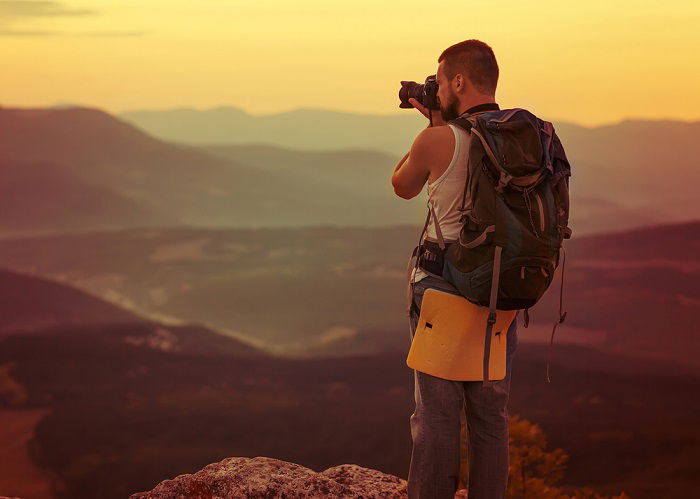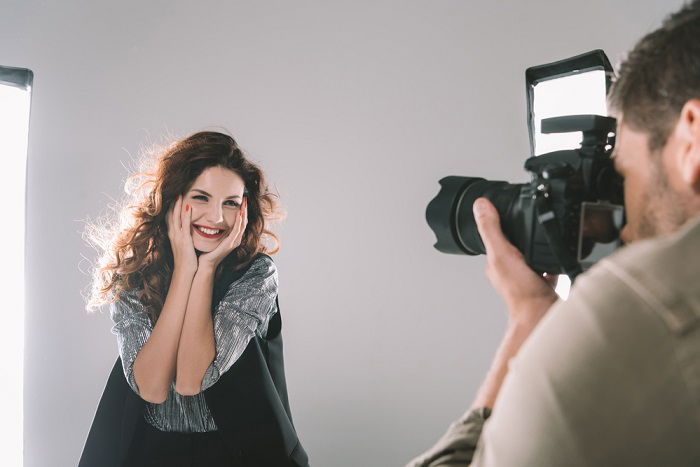The bio page is an important part of your website. It’s something that potential clients will look at to get an idea about the person behind the pictures. In this post, we’ll help you write an awesome photographer bio for your professional website. We have tips, suggestions, and the dos and don’ts for the perfect bio.
How a Photographer Bio Page Can Help Your Website
The short answer is yes. As a photographer, you may think your portfolio speaks for itself. The logic may be to let the photos do the talking. The bulk of your website will be dedicated to your photography work, but the bio page also plays a crucial role on your website. Your portfolio is your shop window. It shows what you have to offer as a photographer. But a good bio introduces the viewer to the shopkeeper behind the glass. It adds heart and depth, showing that you’re more than just a storefront. It shows you’re a fully formed professional photographer. No matter how great your photos are, the lack of a personal page can leave your website feeling stale and flat. A good gallery will get people looking, but potential clients want to know the photographer behind the photos. The bio can take the form of an “About Me” page. Other photographers prefer to have their personal bio on the home page of their website, serving as an introduction to themselves and their work. Both options work well. Don’t hide the personal section in the dark depths of your website. It doesn’t have to be the first thing visitors see, but it should be easy to find. It’s something clients and enthusiasts will look at.
How to Write a Photographer Bio
Now we’ll get into the nuts and bolts of writing a photographer bio for your website. We’ll give you some valuable suggestions, along with some of the dos and don’ts. Of course, you should avoid typos and grammatical errors. But we’ll take a look at the finer points for writing an excellent photographer bio.
Keep It Simple
Your photographer bio offers the first impression to clients and collaborators who are new to your work. They want to get a flavour of who you are and how you work. They don’t want to get lost in a maze of metaphors. Use simple language and stay on topic. Avoid long and complicated sentences with unnecessary punctuation marks. Be concise, and don’t get carried away. You’re writing a photography bio, not Ulysses. For simple sentence structure, look to Ernest Hemingway. Or, if you don’t have the time to read A Farewell To Arms, use the Hemingway Editor app. It’ll help you trim down your baggy passages, and it’s free to use. Grammarly is another excellent tool for writing. The app highlights grammatical errors and spelling mistakes, meaning you won’t overlook any problems before publishing the bio online. Do keep your sentences simple and concise. Be clear and stay on topic. Don’t get carried away with your language. Avoid complicated or unnecessary punctuation.
Introduce Yourself
The first sentence is critical when writing a bio. It introduces you as a professional and sets the tone for what’s to come. The reader will know if they want to continue after just a few words. Use the first sentences to introduce yourself. Tell the reader your name and what you do. You can also add some extra details, like your location. But don’t get carried away. Start with your name or your professional handle. Then tell them what kind of photographer you are. Saying “photographer” is far too broad, so you’ll need to be more specific. Are you a sports or wildlife photographer? Or is film photography your thing? Be clear about what you do as a professional photographer. But keep it short and sweet. The reader doesn’t need to know which camera you use or your favourite film stock. Do be clear and concise. Treat it like an in-person introduction, keeping it short and sweet. Don’t include too many specifics or ramble on.
Let Your Personality Shine in Your Bio
Many photographers keep their bios formal and very matter-of-fact. Other’s like to use humour to make their bio more memorable. You can go either way, as long as you’re portraying yourself naturally. This is your photographer bio. It should reflect your personality as a person and as a photographer. The words need to connect you to the rest of your website without misrepresenting yourself to employers. If you’re a serious professional, forget the jokes and stick to the facts. If your photography work is full of fun, feel free to inject some humour. Be careful not to go overboard. Remember, photography is your business. When you’re thinking about style, be true to yourself. Don’t force jokes into your bio if you’re not funny. And don’t suppress the lighter side of your personality if you are. Do use your personality to create a unique and memorable bio. Don’t force jokes where they’re not needed. And don’t misrepresent yourself.
Don’t Focus On Size
When it comes to website bios, bigger isn’t always better. The word count of your bio will depend on several factors. You don’t need to focus on hitting a thousand words. You need to make sure the content is valid. One factor that will influence the length of your bio is style. If you don’t enjoy writing, keeping it short will suit your personality. If you have a narrative style of photography, maybe your bio will take on a narrative style as well. Where you are in your career is another thing to consider. If you’re new to the photography business, you’ll have less experience to reference. There’s no need to pad out the text with gigs that aren’t genuinely noteworthy. Do be true to your style and keep it valid. Don’t add unnecessary words to stretch out the word count.
Stay Relevant
Whether your bio is short or long, the main thing is to stay relevant. Fill your paragraphs with valuable information about yourself and your photography work. A potential client won’t stick around long if you don’t hold their attention. They don’t want to read your life story. And they don’t need to know about your favourite color or which Spice Girl you had a crush on in 1997. Focusing on yourself as a professional is one of the most important things about the bio. You can give a creative account of your photography journey, telling the reader why you’ve chosen your niche, but stay on topic and keep it interesting. If you’ve had paid commissions and photography gigs, feel free to include them. Seeing that you’ve worked with others before will put many employers at ease, especially if it’s a well-known name. If you’re new to the industry and don’t have any previous commissions to speak of, don’t include any. Don’t create fake examples or exaggerate things that don’t deserve exaggeration. Photography awards are another part of your journey as an artist and professional. Including them will elevate your bio and can add an element of prestige to your name and catalog. If you are an award-winning photographer, be careful not to brag. There’s no problem including your awards in your bio, but stay humble. Don’t become boastful or speak poorly of the other competitors. Look at the websites of your favourite photographers. Use their work as examples to influence your own bio. This will help you determine what is important information and what is filler. Do stay relevant to your photography career. Include professional achievements and awards. Stay humble. Don’t give your life story. Don’t boast, and don’t put others down.
Use Your Professional Language
When I say “use your professional language”, I don’t mean cutting out the swear words and profanities. Of course, you should avoid these. But I mean you should write your bio with the language you usually use. If you speak to clients in English, you should write the bio in that language. If you’re bilingual, you can have two copies of the text, one in each language. If your first language is English, you might not need to give this much thought. It’s an international language that is still spreading in usage. The same applies if you speak Spanish in South America. Another aspect to think about is who you’re trying to appeal to. If you’re trying to connect to international clients, having an English copy of your bio can be beneficial. Don’t write in languages you aren’t confident in. It’s easy to put your bio into Google translate and have the text in any language. But you don’t want to give the impression you can speak languages you can’t. Also, having a page full of bad translations will make your website look unprofessional and messy. Do stick to the languages you feel confident working in. Don’t translate your bio into 30 languages.
Include a Photo
In writing a bio, you’re creating a written portrait of yourself. But including a photograph of yourself can add a human touch. Unless you’re a self-portrait artist, you might not appear in your own gallery, so it’s nice to put a face to a name. The photograph you choose should fit the style of your work. You can have a portrait in your own style if you’re a portrait photographer. If you’re a nature or wildlife photographer, you can have a shot of yourself in action. As always, keep it relevant and professional. Your favourite photo from a drunken night out might not be appropriate. Do use an image that matches your photography style. Don’t use anything unprofessional.
Conclusion
Writing the perfect photographer bio isn’t easy. You have to give a good account of yourself as a person and a photographer. You have to strike a balance between informative and relevant. New clients want to know a bit about you and your career, but they don’t want a life story. Only write about things that are relevant to your work as a photographer. It’s a professional website, not a dating profile. I hope we’ve given you what you need to start writing the perfect photographer bio for your website. Creating a website is a great way to showcase your work online. Check out our Social Success Strategies ebook to get your work seen by an even bigger platform! The images in this article are provided by depositphotos.com.










